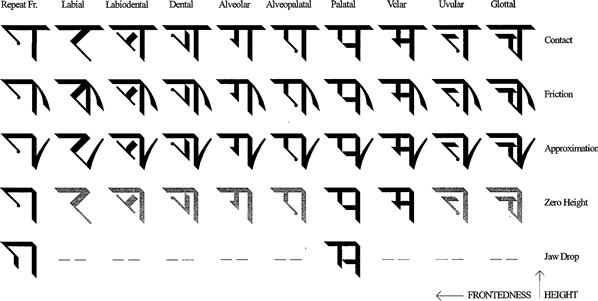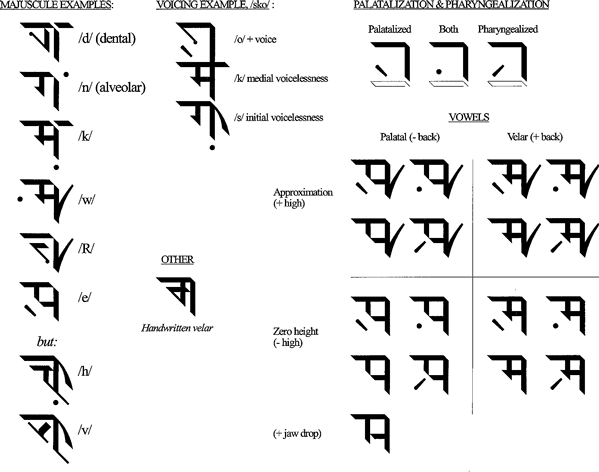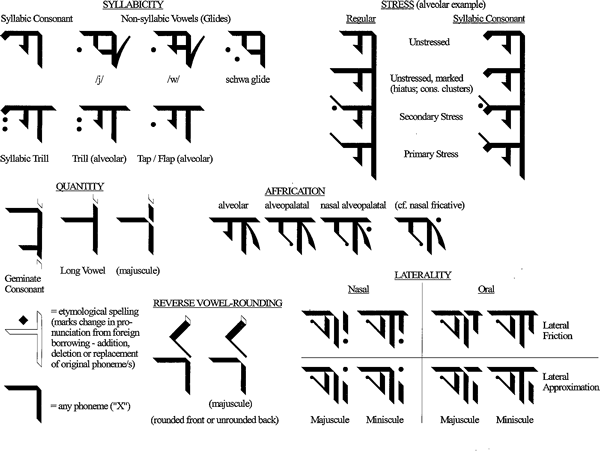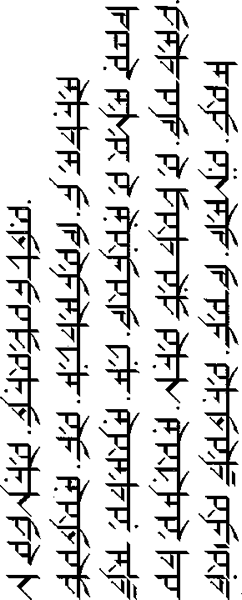Old Lusitanian is an "analytic" script invented by Doug Barton to write his invented language by the same name. The script combines various elements to produce "letters", and the language is based in part on Portuguese. The name Lusitanian comes from the Latin name for Portugual: Lusitania.
This chart sets out the basic Old Lusitanian characters in a matrix.

The vertical axis shows degree of articulatory stricture. Starting from the first full row on bottom (in Old Lusitanian everything including charts and numbering begins at the bottom right), zero stroke indicates zero height or stricture. The tongue rests in neutral position in terms of height, though frontedness may vary. The sounds here can be only vowels. Since vowels can only be produced in the area of maximum resonance or height in the vocal tract, all characters in this row except palatal and velar are grayed-out. Next up are the approximants which include the traditional "high" vowels and the approximant consonants. The tongue is raised, but not enough to produce friction or contact. Approximation is marked by an upward-sweeping stroke to the right of the frontedness character (all height strokes are on the right - the fist thing encountered in a character). Moving up a row are the fricatives. Friction is marked by a stroke sweeping down from the top of the character. The top row shows articulatory contact, marked by a horizontal stroke attached to the top of the frontedness character. It is the highest stroke visually. Any sound produced by contact between the mobile and immobile articulators is marked this way or similarly - taps and trills, oral, nasal and lateral stops.
The vertical axis shows degree of articulatory stricture. Starting from the first full row on bottom (in Old Lusitanian everything including charts and numbering begins at the bottom right), zero stroke indicates zero height or stricture. The tongue rests in neutral position in terms of height, though frontedness may vary. The sounds here can be only vowels. Since vowels can only be produced in the area of maximum resonance or height in the vocal tract, all characters in this row except palatal and velar are grayed-out. Next up are the approximants which include the traditional "high" vowels and the approximant consonants. The tongue is raised, but not enough to produce friction or contact. Approximation is marked by an upward-sweeping stroke to the right of the frontedness character (all height strokes are on the right - the fist thing encountered in a character). Moving up a row are the fricatives. Friction is marked by a stroke sweeping down from the top of the character. The top row shows articulatory contact, marked by a horizontal stroke attached to the top of the frontedness character. It is the highest stroke visually. Any sound produced by contact between the mobile and immobile articulators is marked this way or similarly - taps and trills, oral, nasal and lateral stops.
Dictionary ("alphabetical") order follows the order of this matrix: the first words in a dictionary begin with glottal approximants, then glottal fricatives, then glottal stops, then uvular approximants and so on until the last words in a dictionary begin with labial stops.
Combining only height and frontedness elements, the matrix produces symbols for the following phonemes:

The bottommost entry does not represent a degree of height lower than zero. /æ/ is simply an /ɛ/ articulated with simultaneous jaw drop. The tongue body still remains in neutral position. The palatal area is the only location in the vocal tract with enough vertical room for jaw drop to affect the quality of vowel sounds.
Where no values are given, these sounds are either uncommon, or too indistinct to be used in speech (although Old Lusitanian can show them). Where voiceless/voiced values alternate between friction and approximation (e.g. the labials, uvulars and glottals), the missing values represent sounds requiring too much pulmonic effort to be commonly used in speech, at least contrastively. Among the vowels only the voiced members are shown. While vowels can certainly be voiceless (e.g. Japanese), whispered vowels are not used contrastively in any language.
To distinguish the voiceless and voiced sounds above, the Old Lusitanian script employs connection between letters. A voiced sound connects to the preceding character via the baseline of writing (the "backbone" or vertical stroke of each frontedness character). Initial or independent voiced sounds do not need to be marked. Voiceless sounds are separated from their preceding characters by a small gap in the baseline, formed naturally by the nib-angle of the writing instrument. These gaps do not require extra spaces for the same reason above, meaning voiceless letters do not affect the length of a written word, except when initial. Initial/independent voiceless sound are marked by a dot before the baseline which, like the gap, signifies a break in voice.
The script is able to show other states of the glottis such as creak, as well as glottal timing (aspiration). No examples are given here.
There are certainly more sounds in Old Lusitanian (or in any language) than shown above. Phonetically, these other sounds are simply the base sounds above produced with some coarticulation, secondary articulation, or both. The chart below illustrates some of them. Here is how the script forms the most common:
The horizontal contact stroke of oral stops becomes a dot in nasal stops. The separation of the dot from the character represents the lowered velum, which allows partial airstream through the nose. In other nasals, specifically nasal vowels, this dot is lowered to near the bottom of the character in order to show articulatory height simultaneously.
Lateral articulations are marked by a vertical stroke parallel to the baseline. This stroke's proximity to the contact stroke (laterals are still central stops) shows whether the lateral airflow is approximant or fricative: up high to mark lateral friction, lower down for approximation.
This is dealt with more below along with stress, but here we are concerned with glides and taps/trills. The only thing distinguishing an alveolar /d/, for example, from an trilled or tapped r is the feature syllabicity. The vowels /i/ and /u/ are distinguished from their respective glides /j/ and /w/ by the same feature. In Old Lusitanian a dot to the left of the character marks a vowel as -syllabic and -sustainable, and a consonant (which usually isn't syllabic to begin with) as -sustainable. An tapped r is not prolongable in articulation because if it were held, a /d/ would result. Likewise w held in articulation becomes a /u/. A trilled r is marked by two of these dots on the left, representing vibration or trill. Since the vibration of a trill is sustainable (though not the individual taps), the two dots also mark mixed sustainability.
Each Old Lusitanian letter – by which we mean, here, the body or frontedness element – is identically-sized and occupies only half of the square allotted to it, namely the northeast half. The southwest half is reserved for marking palatalization and/or pharyngealization. Like Irish and Russian, Old Lusitanian employs palatalization contrastively. But outside of transcribing the Arabic "emphatics" and pharyngeals, pharyngealized consonants are little used in Old Lusitanian; the only (relatively) common one in native words is the voiceless pharyngealized fricative /ħ/.
In the script palatalized letters are marked with a forward-pointing stroke or "grave accent", which signifies the tongue body in a forward position. Pharyngealized letters are marked with a backward pointing stroke or acute accent, showing the body of the tongue backed. A dot in place of both strokes marks simultaneous palatalization and phayngealization, a feature of some vowels, such as the schwa, or the dark Russian у, which is a +palatal +pharyngeal high velar vowel. This leads to the next point - even if there were no palatalized or pharyngealized consonants in Old Lusitanian, marking palatalization and pharyngealization is still necessary: the articulation that produces palatalized and phayngealized consonants is the same articulation that produces tense and "dark" vowels. In Old Lusitanian there is no difference in marking tense vowels and palatalized consonants, or their phayngealized counterparts; the graphic system simply reflects the same phonetic phenomena.
Vowel rounding (lip rounding or spreading) is shown below, as is majusculization and stress.
Old Lusitanian majuscules are the same size as miniscules but have their northeast corners "shaved" off. In the case of fricatives however, this shaving would produce an unattractive result (the fricative stroke would not reach the baseline), so majuscule fricatives are marked instead by a downward flourish from the baseline to the right. In handwriting, all majuscules are marked with this flourish.
Since stress is free and contrastive in Old Lusitanian, it is marked in the script. Every word, regardless of the number of syllables it contains, is marked with stress, the only exception being particles, which by nature are stressless monosyllables. An upward flourish from the horizontal bar of the frontedness character marks primary stress; the letter so marked begins the stressed syllable and is not necessarily the vowel of that syllable. Secondary stress and hiatus are marked by modifications to this flourish. Similarly, syllabic consonants are marked by a downward stroke from the horizontal bar. This is the same syllabic dot referenced above, but when attached to the bar it marks a sound with +syllabicity. Syllabic consonants are found in English and some Indian languages, usually r or l. Both stress and syllabicity can be shown together.



nasˈsa ˈlivri ˈseːh huˈmə̃ ˈʃak ɛd iˈgwaw pri ʤĩːˈdaʤ i ˈhɛːtuʃ. lɒː ẽdoˈaw kõ haˈzãw̃ i aˈbʲo jæʔ ʤɩˈvaw si kõduˈzih ˈs otru b ɩʃˈpri ˈfraʧʲɛstvə.
All human beings are born free and equal in dignity and rights.
They are endowed with reason and conscience and should act towards
one another in a spirit of brotherhood.
(Article 1 of the Universal Declaration of Human Rights)
Constructed scripts for: Ainu | Arabic | Chinese languages | Dutch | English | Hawaiian | Hungarian | Japanese | Korean | Lingala | Malay & Indonesian | Persian | Tagalog / Filipino | Russian | Sanskrit | Spanish | Taino | Turkish | Vietnamese | Welsh | Other natural languages | Colour-based scripts | Tactile scripts | Phonetic/universal scripts | Constructed scripts for constructed languages | Adaptations of existing alphabets | Fictional alphabets | Magical alphabets | A-Z index | How to submit a constructed script
[top]
You can support this site by Buying Me A Coffee, and if you like what you see on this page, you can use the buttons below to share it with people you know.

If you like this site and find it useful, you can support it by making a donation via PayPal or Patreon, or by contributing in other ways. Omniglot is how I make my living.
Note: all links on this site to Amazon.com, Amazon.co.uk
and Amazon.fr
are affiliate links. This means I earn a commission if you click on any of them and buy something. So by clicking on these links you can help to support this site.
[top]